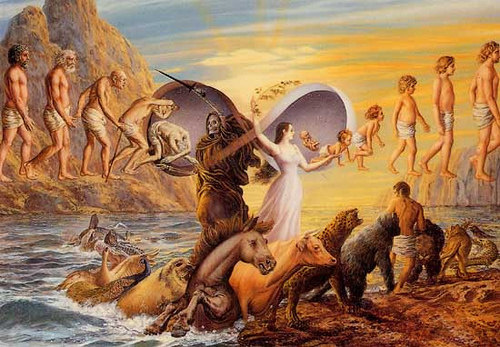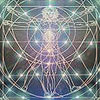Historical References of Reincarnation
The whole process of transmigration is expressed in Eastern philosophy by the doctrine of the Reincarnation of the individual soul. Although this doctrine is commonly rejected in the West, it is unreservedly accepted by the vast majority of mankind of the present day, as it was in past centuries. The scientific explanation of this theory we find nowhere except in the writings of the Hindus; still we know that from very ancient times it was believed by the philosophers, sages and prophets of different countries. The ancient civilization of Egypt was built upon a crude form of the doctrine of Reincarnation. Herodotus says: “The Egyptians propounded the theory that the human soul is imperishable, and that where the body of any one dies it enters into some other creature that may be ready to receive it.” Pythagoras and his disciples spread it through Greece and Italy. Pythagoras says: “All has soul; all is soul wandering in the organic world, and obeying eternal will or law.”
In Dryden’s Ovid we read:—
“Death has no power the immortal soul to slay,
That, when its present body turns to clay,
Seeks a fresh home, and with unlessened might
Inspires another frame with life and light.”
It was the keynote of Plato’s philosophy. Plato says: “Soul is older than body. Souls are continually born over again into this life.” The idea of Reincarnation was spread widely in Greece and Italy by Pythagoras, Empedocles, Plato, Virgil and Ovid. It was known to the Neo-Platonists, Plotinus and Proclus. Plotinus says: “The soul leaving the body becomes that power which it has most developed. Let us fly then from here below and rise to the intellectual world, that we may not fall into a purely sensible life by allowing ourselves to follow sensible images….” It was the fundamental principle of the religion of the Persian Magi. Alexander the Great accepted this idea after coming in contact with the Hindu philosophers. Julius Caesar found that the Gauls had some belief regarding the pre-existence of the human soul. The Druids of old Gaul believed that the souls of men transmigrate into those bodies whose habits and characters they most resemble. Celts and Britons were impressed with this idea. It was a favorite theme of the Arab philosophers and many Mahomedan Sufis. The Jews adopted it after the Babylonian captivity. Philo of Alexandria, who was a contemporary of Christ, preached amongst the Hebrews the Platonic idea of the pre-existence and rebirth of human souls. Philo says: “The company of disembodied souls is distributed in various orders. The law of some of them is to enter mortal bodies, and after certain prescribed periods be again set free.” John the Baptist was according to the Jews a second Elijah; Jesus was believed by many to be the re-appearance of some other prophet. (See Matt, xvi, 14, also xvii, 12.) Solomon says in his Book of Wisdom: “I was a child of good nature and a good soul came to me, or rather because I was good I came into an undefiled body.”
The Talmud and Cabala teach the same thing. In the Talmud it is said that Abel’s soul passed into the body of Seth, and then into that of Moses. Along with the spread of the Cabala this doctrine (which was known as Transmigration and Metempsychosis) “began to take root in Judaism and then it gained believers even among men who were little inclined towards Mysticism. Juda ben Asher (Asheri) for instance, discussing this doctrine in a letter to his father endeavored to place it upon a philosophical basis.” (Jewish Encyclopedia, Vol. XII, p. 232.) We also read, “The Cabalists eagerly adopted the doctrine on account of the vast field it offered to mystic speculations. Moreover it was almost a necessary corollary of their psychological system. The absolute condition of the soul is, according to them, its return, after developing all those perfections, the germs of which are eternally implanted in it, to the Infinite Source from which it emanated. Another term of life must therefore be vouchsafed to those souls which have not fulfilled their destiny here below, and have not been sufficiently purified for the state of union with the Primordial Cause. Hence if the soul, on its first assumption of a human body and sojourn on earth, fails to acquire that experience for which it descended from heaven and becomes contaminated by that which is polluting, it must reinhabit a body till it is able to ascend in a purified state through repeated trials.” This is the theory of the Zohar, which says: “All souls are subject to transmigration; and men do not know the ways of the Holy One, blessed be He! They do not know that they are brought before the tribunal both before they enter into this world and after they leave it; they are ignorant of the many transmigrations and secret probations which they have to undergo, and of the number of souls and spirits which enter into this world and which do not return to the palace of the Heavenly King. Men do not know how the souls revolve like a stone which is thrown from a sling. But the time is at hand when these mysteries will be disclosed.” (Zohar, II, 99 b.)
Like many of the Church Fathers the Cabalists used as their main argument in favor of the doctrine of metempsychosis the justice of God. But for the belief in metempsychosis, they maintained, the question why God often permits the wicked to lead a happy life while many righteous are miserable would be unanswerable. Then too the infliction of pain upon children would be an act of cruelty unless it is imposed in punishment of sin committed by the soul in a previous state. Isaac Abravanel sees in the commandment of the Levirate a proof of the doctrine of metempsychosis for which he gives the following reasons: (1) God in His mercy willed that another trial should be given to the soul, which having yielded to the sanguine temperament of the body had committed a capital sin, such as murder, adultery, etc.; (2) it is only just that when a man dies young a chance should be given to his soul to execute in another body the good deeds which it had not time to perform in the first body; (3) the soul of the wicked sometimes passes into another body in order to receive its deserved punishment here below instead of in the other world where it would be much more severe. (Commentary on Deuteronomy, XXV, 5.)
Christianity is not exempt from this idea. Origen and other Church Fathers believed in it. Origen says: “For God, justly disposing of his creatures according to their desert, united the diversities of minds in one congruous world, that he might, as it were, adorn his mansion (in which ought to be not only vases of gold and silver, but of wood also and clay, and some to honor and some to dishonor) with these diverse vases, minds or souls. To these causes the world owes its diversity, while Divine Providence disposes each according to his tendency, mind and disposition.” He also says: “I think this is a question how it happens that the human mind is influenced now by the good, now by the evil. The causes of this I suspect to be more ancient than this corporeal birth.” The idea of Reincarnation spread so fast amongst the early Christians that Justinian was obliged to suppress it by passing a law in the Council of Constantinople in 538 A.D. The law was this: “Whoever shall support the mythical presentation of the pre-existence of the soul, and the consequently wonderful opinion of its return, let him be Anathema.” The Gnostics and Manichaeans propagated the tenets of Reincarnation amongst the mediaeval sects such as the Bogomiles and Paulicians. Some of the followers of this so-called erroneous belief were cruelly persecuted in 385 A.D.
In the seventeenth century some of the Cambridge Platonists, as Dr. Henry More and others, accepted the idea of rebirth. Most of the German philosophers of the middle ages and of recent days have advocated and upheld this doctrine. Many quotations can be given from the writings of great thinkers, like Kant, Scotus, Schelling, Fichte, Leibnitz, Schopenhauer, Giardano Bruno, Goethe, Lessing, Herder and a host of others. The great skeptic Hume says in his posthumous essay on “The Immortality of the Soul,” “The metempsychosis is therefore the only system of this kind that philosophy can hearken to.” Scientists like Flammarion and Huxley have supported this doctrine of Reincarnation. Professor Huxley says: “None but hasty thinkers will reject it on the ground of inherent absurdity. Like the doctrine of evolution itself, that of transmigration has its roots in the world of reality.” (“Evolution and Ethics,” p. 61.)
Some of the theological leaders have preached it. The eminent German theologian Dr. Julius Müller supports this theory in his work on “The Christian Doctrine of Sin.” Prominent theologians, such as Dr. Dorner, Ernesti, Rückert, Edward Beecher, Henry Ward Beecher, Phillips Brooks, preached many a time touching the question of the pre-existence and rebirth of the individual soul. Swedenborg and Emerson maintained it. Emerson says in his essay on Experience, “We wake and find ourselves on a stair. There are stairs below us which we seem to have ascended; there are stairs above us, many a one, which go upward and out of sight.”
Almost all of the poets, ancient or modern, profess it. William Wordsworth says in “Intimations of Immortality:”—
“The soul that rises with us, our life’s star,
Hath had elsewhere its setting,
And cometh from afar.”
Tennyson writes in the “Two Voices;”
“Or, if through lower lives I came—
Tho’ all experience past became,
Consolidate in mind and frame—
I might forget my weaker lot;
For is not our first year forgot?
The haunts of memory echo not.”
Walt Whitman says in “Leaves of Grass:”
“As to you, Life, I reckon you are the leavings of many deaths,
No doubt I have died myself ten thousand times before.”
Similar passages can be quoted from almost all the poets of different countries. Even amongst the aboriginal tribes of Africa, Asia, North and South America, traces of this belief in the rebirth of souls is to be found. Nearly three-fourths of the population of Asia believe in the doctrine of Reincarnation, and through it they find a satisfactory explanation of the problem of life. There is no religion which denies the continuity of the individual soul after death.
Those who do not believe in Reincarnation try to explain the world of inequalities and diversities either by the one-birth theory or by the theory of hereditary transmission. Neither of these theories, however, is sufficient to explain the inequalities that we meet with in our everyday life. Those who believe in the one-birth theory, that we have come here for the first and last time, do not understand that the acquirement of wisdom and experience is the purpose of human life; nor can they explain why children who die young should come into existence and pass away without getting the opportunity to learn anything or what purpose is served by their coming thus for a few days, remaining in utter ignorance and then passing away without gaining anything whatever. The Christian dogma, based on the one-birth theory, tells us that the child which dies soon after its birth is sure to be saved and will enjoy eternal life and everlasting happiness in heaven. The Christians who really believe in this dogma ought to pray to their heavenly Father for the death of their children immediately after their birth and ought to thank the merciful Father when the grave closes over their little forms. Thus the one-birth theory of Christian theology does not remove any difficulty.
Two great religions, Judaism with its two offspring—Christianity and Mahomedanism—and Zoroastrianism, still uphold the one-birth theory.
The followers of these, shutting their eyes to the absurdity and unreasonableness of such a theory, believe that human souls are created out of nothing at the time of the birth of their bodies and that they continue to exist throughout eternity either to suffer or to enjoy because of the deeds performed during the short period of their earthly existence. Here the question arises why should a man be held responsible throughout eternity for the works which he was forced or predestined to perform by the will of the Lord of the universe? The theory of predestination and grace, instead of explaining the difficulty, makes God partial and unjust. If the omnipotent personal God created human souls out of nothing, could He not make all souls equally good and happy? Why does He make one to enjoy all the blessings of life and another to suffer all miseries throughout eternity? Why is one born with good tendencies and another with evil ones? Why is one man virtuous throughout his life and another bestial? Why is one born intelligent and another idiotic? If God out of His own will made all these inequalities, or, in other words, if God created one man to suffer and another to enjoy, then how partial and unjust must He be! He must be worse than a tyrant. How can we worship Him, how call Him just and merciful?
Some people try to save God from this charge of partiality and injustice by saying that all good things of this universe are the work of God, and all evil things are the work of a demon or Satan. God created everything good, but it was Satan who brought evil into this world and made everything bad. Now let us see how far such a statement is logically correct. Good and evil are two relative terms; the existence of one depends upon that of the other. Good cannot exist without evil, and evil cannot exist without being related to good. When God created what we call good, He must have created evil at the same time, otherwise He could not create good alone. If the creator of evil, call him by whatever name you like, had brought evil into this world, he must have created it simultaneously with God; otherwise it would have been impossible for God to create good, which can exist only as related to evil. As such they will have to admit that the Creators of good and evil sat together at the same time to create this world, which is a mixture of good and evil. Consequently, both of them are equally powerful, and limited by each other. Therefore neither of them is infinite in powers or omnipotent. So we cannot say that the Almighty God of the universe created good alone and not the evil.
Another argument which the Vedantists advance in support of the theory of Reincarnation is that “Nothing is destroyed in the universe.” Destruction in the sense of the annihilation of a thing is unknown to the Vedantic philosophers, just as it is unknown to the modern scientists. They say “non-existence can never become existence and existence can never become non-existence;” or, in other words, that which did not exist can never exist, and conversely that which exists in any form can never become non-existent. This is the law of nature. As such, the impressions or ideas which we now have, together with the powers which we possess, will not be destroyed but will remain with us in some form or other. Our bodies may change, but the powers, Karma, Samskaras or impressions and the materials which manufactured our bodies must remain in us in an unmanifested form. They will never be destroyed. Again science tells us that that which remains in an unmanifested or potential state must at some time or other be manifested in a kinetic or actual form. Therefore we shall get other bodies, sooner or later. It is for this reason said in the “Bhagavad Gîtâ”: “Birth must be followed by death and death must be followed by birth.” Such a continuously recurring series of births and deaths each germ of life must go through. Another consideration is that the beginning, ending and continuing are conceptions of the human mind; their significance depends entirely upon our conception of time. But we all know that time has no absolute existence. It is merely a form of our knowledge of our own existence in relation to that of nature. The conception of time vanishes at the sleep of death, just as it does every night when we are in sound sleep. Death resembles the state of our sound sleep. The soul wakes up from the sleep of death just in the same manner as the insects awake in spring after sleeping the long and rigid winter-sleep, as a chrysalis in the bed of a cocoon spun by itself in autumn. Nature teaches us the great lesson of rebirth and the similarity between sleep and death by the rejuvenation of the chrysalis in the spring. After death the soul wakes up and puts on or manufactures the garment of a new body, just in the same manner as we put on new clothes after throwing away the old and worn-out ones. Thus the soul continues to manifest itself over and over again either on the human or any other plane of existence, being bound by the Law of Karma or of Cause and Sequence.
“Death, so called, is but older matter dressed
In some new form. And in a varied vest,
From tenement to tenement though tossed,
The soul is still the same, the figure only lost.”
Poem on Pythagoras, Dryden’s Ovid.
Here it may be asked, if we existed before our birth why do we not remember? This is one of the strongest objections often raised against the belief in pre-existence. Some people deny the existence of the soul in the past simply because they cannot remember the events of their past. Others, again, who hold memory as the standard of existence, say, if our memory of the present ceases to exist at the time of death, with it we shall also cease to be; we cannot be immortal; because they hold that memory is the standard of life, and if we do not remember then we are not the same beings.
Vedanta answers these questions by saying that it is possible for us to remember our previous existences. Those who have read “Raja Yoga” will recall that in the 18th aphorism of the third chapter it is said: “By perceiving the Samskâras one acquires the knowledge of past lives.” Here the Samskâras mean the impressions of the past experience which lie dormant in our subliminal self, and are never lost. Memory is nothing but the awakening and rising of latent impressions above the threshold of consciousness. A Raja Yogi, through powerful concentration upon these dormant impressions of the subconscious mind, can remember all the events of his past lives. There have been many instances in India of Yogis who could know not only their own past lives but correctly tell those of others. It is said that Buddha remembered five hundred of his previous births.
Our subliminal self, or the subconscious mind, is the storehouse of all the impressions that we gather through our experiences during our lifetime. They are stored up, pigeon-holed there, in the Chitta, as it is called in Vedanta. “Chitta” means the same subconscious mind or subliminal self which is the storehouse of all impressions and experiences. And these impressions remain latent until favorable conditions rouse them and bring them out on the plane of consciousness. Here let us take an illustration: In a dark room pictures are thrown on a screen by lantern-slides. The room is absolutely dark. We are looking at the pictures. Suppose we open a window and allow the rays of the midday sun to fall upon the screen. Would we be able to see those pictures? No. Why? Because the more powerful flood of light will subdue the light of the lantern and the pictures. But although they are invisible to our eyes we cannot deny their existence on the screen. Similarly, the pictures of the events of our previous lives upon the screen of the subliminal self may be invisible to us at present, but they exist there. Why are they invisible to us now? Because the more powerful light of sense-consciousness has subdued them. If we close the windows and doors of our senses from outside contact and darken the inner chamber of our self, then by focusing the light of consciousness and concentrating the mental rays we shall be able to know and remember our past lives, and all the events and experiences thereof.
These dormant impressions, whether we remember them or not, are the chief factors in moulding our individual characters with which we are born, and they are the causes of the inequalities and diversities which we find around us. When we study the characters and powers of geniuses and prodigies we cannot deny the pre-existence of the soul. Whatever the soul has mastered in a previous life manifests in the present. The memory of particular events is not so important. If we possess the wisdom and knowledge which we gathered in our previous lives, then it matters very little whether or not we remember the particular events, or the struggles which we went through in order to gain that knowledge. Those particular things may not come to us in our memory, but we have not lost the wisdom. Now, study your own present life and you will see that in this life you have gained some experience. The particular events and the struggles which you went through are passing out of your memory, but the experience, the knowledge which you have gained through that experience, has moulded your character, has shaped you in a different manner.
Then, again, we find among ourselves persons who are born with some wonderful powers. Take, for instance, the power of self-control. One is born with the power of self-control highly developed, and that self-control may not be acquired by another after years of hard struggle. Why is there this difference? Bhagavan Sri Ramakrishna was born with God-consciousness, and he went into the highest state of Samâdhi when he was four years old; but this state is very difficult for other Yogis to acquire. There was a Yogi who came to see Ramakrishna. He was an old man and possessed wonderful powers, and he said: “I have struggled for forty years to acquire that state which is natural with you.” There are many such instances which show that pre-existence is a fact, and that these latent or dormant impressions of previous lives are the chief factors in moulding the individual character without depending upon the memory of the past. Because we cannot remember our past, because of the loss of memory of the particular events, the soul’s progress is not arrested. The soul will continue to progress further and further, even though the memory may be weak.
Each individual soul possesses this storehouse of previous experiences in the background, in the subconscious mind. Take the instance of two lovers. What is love? It is the attraction between two souls. This love does not die with the death of the body. True love survives death and continues to grow, to become stronger and stronger. Eventually it brings the two souls together and makes them one. The theory of pre-existence alone can explain why two souls at first sight know each other and become attached to each other by the tie of friendship. This mutual love will continue to grow and will become stronger, and in the end will bring these lovers together, no matter where they go. Therefore, Vedanta does not say that the death of the body will end the attraction or the attachment of two souls; but as the souls are immortal so their relation will continue forever.
The Yogis know how to develop memory and how to read past lives. They say, time and space exist in relation to our present mental condition; if we can rise above this plane, our higher mind sees the past and future just as we see things before our eyes. Nothing will remain unknown to you, the Knower of the universe. When the all-knowing Divine Self will manifest through you, time and space will vanish and past and future will be changed into the eternal present. Then you will say as Sri Krishna said to Arjuna, in the “Bhagavad Gita:” “Both you and I have passed through many lives; you do not recollect any, but I know them all.” (Ch. iv., 5.)
Posted in Past Life Therapywith comments disabled.






